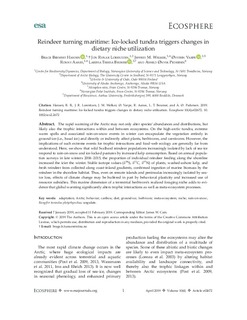| dc.contributor.author | Hansen, Brage Bremset | |
| dc.contributor.author | Lorentzen, Jon Runar | |
| dc.contributor.author | Welker, Jeffrey M. | |
| dc.contributor.author | Varpe, Øystein | |
| dc.contributor.author | Aanes, Ronny | |
| dc.contributor.author | Beumer, Larissa Teresa | |
| dc.contributor.author | Pedersen, Åshild Ø. | |
| dc.date.accessioned | 2019-05-13T12:23:33Z | |
| dc.date.available | 2019-05-13T12:23:33Z | |
| dc.date.created | 2019-05-08T09:33:13Z | |
| dc.date.issued | 2019 | |
| dc.identifier.issn | 2150-8925 | |
| dc.identifier.uri | http://hdl.handle.net/11250/2597438 | |
| dc.description.abstract | The rapid warming of the Arctic may not only alter species’ abundances and distributions, but likely also the trophic interactions within and between ecosystems. On the high‐arctic tundra, extreme warm spells and associated rain‐on‐snow events in winter can encapsulate the vegetation entirely in ground‐ice (i.e., basal ice) and directly or indirectly affect plants, herbivores, and carnivores. However, the implications of such extreme events for trophic interactions and food‐web ecology are generally far from understood. Here, we show that wild Svalbard reindeer populations increasingly isolated by lack of sea‐ice respond to rain‐on‐snow and ice‐locked pastures by increased kelp consumption. Based on annual population surveys in late winters 2006–2015, the proportion of individual reindeer feeding along the shoreline increased the icier the winter. Stable isotope values (δ34S, δ13C, δ15N) of plants, washed‐ashore kelp, and fresh reindeer feces collected along coast‐inland gradients, confirmed ingestion of marine biomass by the reindeer in the shoreline habitat. Thus, even on remote islands and peninsulas increasingly isolated by sea‐ice loss, effects of climate change may be buffered in part by behavioral plasticity and increased use of resource subsidies. This marine dimension of a terrestrial herbivore's realized foraging niche adds to evidence that global warming significantly alters trophic interactions as well as meta‐ecosystem processes. | nb_NO |
| dc.language.iso | eng | nb_NO |
| dc.publisher | Ecological Society of America | nb_NO |
| dc.relation.uri | https://esajournals.onlinelibrary.wiley.com/doi/epdf/10.1002/ecs2.2672 | |
| dc.rights | Navngivelse 4.0 Internasjonal | * |
| dc.rights.uri | http://creativecommons.org/licenses/by/4.0/deed.no | * |
| dc.title | Reindeer turning maritime: Ice-locked tundra triggers changes in dietary niche utilization | nb_NO |
| dc.type | Journal article | nb_NO |
| dc.type | Peer reviewed | nb_NO |
| dc.description.version | publishedVersion | nb_NO |
| dc.source.volume | 10 | nb_NO |
| dc.source.journal | Ecosphere | nb_NO |
| dc.identifier.doi | 10.1002/ecs2.2672 | |
| dc.identifier.cristin | 1696230 | |
| dc.relation.project | Norges forskningsråd: 235503 | nb_NO |
| dc.relation.project | Norges forskningsråd: 223257 | nb_NO |
| dc.relation.project | Norges forskningsråd: 276080 | nb_NO |
| dc.relation.project | Norges forskningsråd: 244647 | nb_NO |
| dc.description.localcode | © 2019 The Authors. This is an open access article under the terms of the Creative Commons Attribution License, which permits use, distribution and reproduction in any medium, provided the original work is properly cited. | nb_NO |
| cristin.unitcode | 194,66,10,0 | |
| cristin.unitname | Institutt for biologi | |
| cristin.ispublished | true | |
| cristin.fulltext | original | |
| cristin.qualitycode | 1 | |

